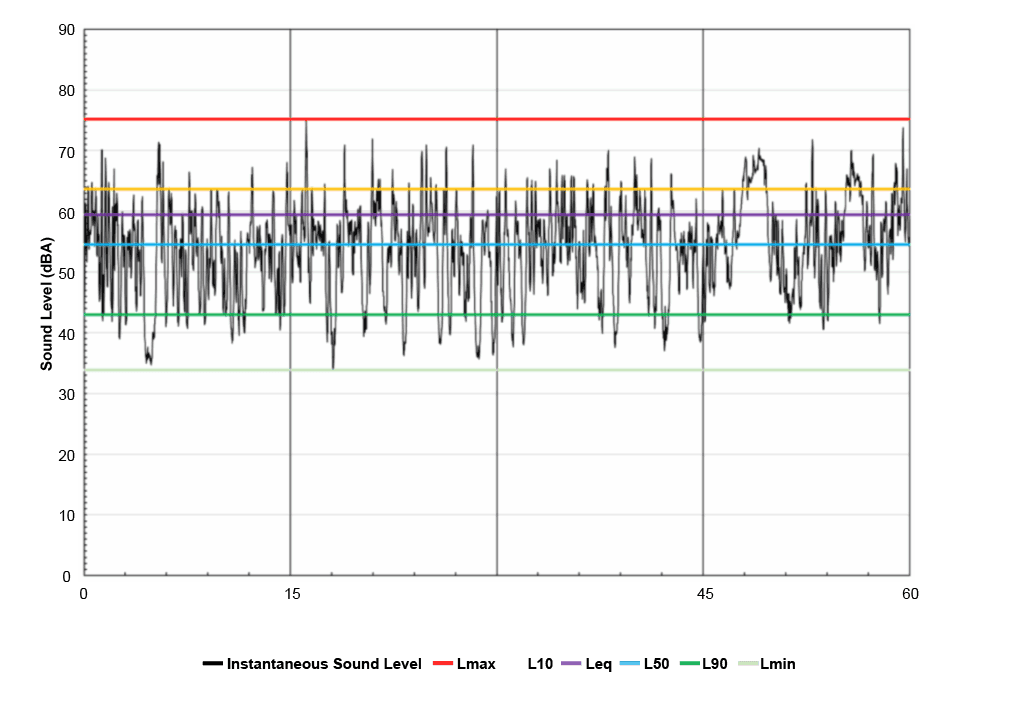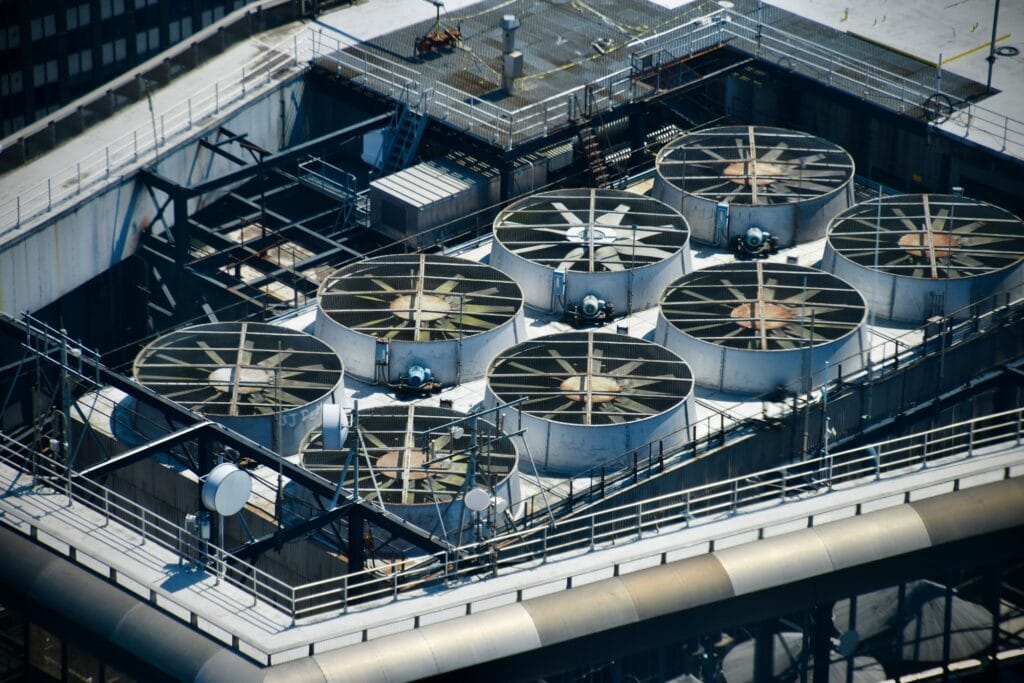01: Introduction

The abundance of the digital age has brought with it a tremendous need for physical data storage space, electrical power (and redundant power), and cooling.
These resources support the housing and operations of all the equipment and infrastructure that maintain huge amounts of data that make modern technologies possible. The facilities that house them—data centers—range from small, room-sized setups in office buildings to sprawling hyperscale campuses of multiple buildings covering hundreds of acres. These data centers underpin all digital infrastructure, including cloud computing, data storage, and network devices. Demand for these facilities has surged and continues to increase with the expansion of media streaming, remote software computation, and the rise of data-intensive AI-powered technologies.
Large changes to the digital landscape come with similarly significant changes to the physical landscape around data centers. Built at an industrial scale and designed for 24/7 operation, they present environmental challenges, from energy and water use to community impacts—the most common of which is noise. The infrastructure needs of data centers mean that they are best sited near the users of the data, but friction is expected when industrial development abuts residential areas. Communities have responded to the uptick in community noise complaints with revamped noise regulations, though the rules of these regulations vary widely across jurisdictions. To ensure responsible development and build community trust, data center developers and design teams must account for these kinds of potential noise impacts early in the planning process.
02: Common Regulatory Frameworks
Qualitative Noise Regulations
Qualitative regulations may come in the form of blanket restrictions on the generation of noise generally, or more specific limits around certain activities (e.g., allowable hours of construction or lawn-mowing). One such example:
It shall be unlawful for any person, firm, or corporation to make, continue, or cause to be made or continued any loud, unnecessary, or unusual noise or any noise which interferes with the normal enjoyment of life or property or disturbs, endangers, or interferes with the public peace and comfort within the limits of the city.
Nuisance-based regulations raise the question: how loud should a data center be? Because qualitative criteria rely on complaint-driven enforcement by local regulators, they offer little guidance in setting clear community noise goals. By the time complaints arise, it’s too late. Developers should instead establish a Project Sound Goal—either project-specific or drawn from generic guidelines—to proactively guide design. To reasonably meet qualitative standards, facilities should aim to minimize annoyance, health impacts, and safety risks from noise. Lessons from other jurisdictions’ regulations can help inform these goals.
Quantitative Noise Regulations
Jurisdictions define acceptable environmental noise levels in different ways. Sound is measured in decibels (dB), a logarithmic ratio of air pressure fluctuations to a reference pressure of 20 micro-Pascals. The decibel, unless otherwise noted, is considered to be un-weighted (dB, or dBZ), meaning no correction has been applied to the amplitude of the sound based on its frequency content. In almost all cases, community sound criteria are given in terms of A-weighted decibels (dBA). The A-weighting adjusts the sound pressure level to account for the differences in human hearing at different frequencies.
Other than the overall A-weighted sound level, the character of a sound also affects community perception. Tonal, intermittent, impulsive, or excessively low-frequency sounds are often judged more negatively than typical broadband noise at the same level. Some regulations therefore use C-weighted decibels (dBC), which include more low-frequency content and are more representative of human response to very loud sounds (>85 dBZ) but less representative than A-weighting for human response to quiet-to-medium sounds. Other approaches may set limits for specific octave bands or define, qualitatively or quantitatively, what kinds of pure tones violate a noise ordinance.
In addition to frequency weighting, sound descriptors are needed to capture variability of sound levels over time. The most common is the A-weighted Equivalent Sound Level (Leq), an average of the sound energy over a given measurement period. Leq provides a single-number representation of environmental sound, as opposed to transient instantaneous sound levels that fluctuate over a wide range. The one-hour Leq, denoted Leq,1-hr, is used as a quantitative metric for many environmental acoustic assessments across the United States. Another metric commonly used to characterize steady state sound levels is the L90, which is defined as the sound level exceeded for 90% of the measurement interval. The L90 is typical of continuous sounds and often similar to the minimum sound level, which can characterize the residual ambient, or background, sound level. It is essential to understand the metrics used by a jurisdiction, not just for the potential sound from the data center, but more importantly for the definition of the ambient, or background sound level. An ambient defined by the Leq will be higher than an ambient defined by the L90 when characterizing the quietest times.
Environmental sound spans a wide range. The example below is from a mid-afternoon measurement in a rural area, near a moderately busy two-lane road. The figure below compares the second-by-second sound levels to the hourly statistical metrics, including Lmax, L10, Leq, L50, L90, and Lmin. The difference between the minimum (34 dBA) and maximum (75 dBA) sound levels observed is over 40 decibels. The average (Leq) in this case is 59 dBA, which is above the median (L50) of 55 dBA and L90 of 43 dBA. The dramatic differences between these various metrics in a single hour of data demonstrate the importance of identifying a quantitative definition of the ambient sound level. Defining “typical” sound is therefore difficult for regulators, and the challenge only increases when considering hourly, daily, or seasonal variability.

Some jurisdictions set fixed sound limits (e.g., 55 dBA), which may be further restricted during evenings, nights, or weekends. Different limits are applied based on the zoning or land use, with lower noise limits for noise-sensitive uses such as homes, schools, daycares, healthcare facilities, and places of worship. Because data centers operate continuously, they must address operations during the most restrictive times of day.
Other criteria are defined based on an allowable increase in sound over existing ambient conditions (e.g., 10 dB increase over ambient). Whether a jurisdiction has a fixed or ambient-based regulation, varying background levels matter: even where fixed limits are generous, low ambient noise can make data center sound more noticeable and may increase the likelihood of community complaints.
Many jurisdictions have weak noise regulations that are easy for developers to meet, but compliance alone rarely ensures project success or strong community relations. Data centers should strive to be good neighbors and understand when it is appropriate to go above and beyond the code minimum.
A cautionary example comes from Virginia, a major data center hub. A jurisdiction had an exemption that stated:
Heating and cooling systems, including but not limited to air conditioners and heat pumps, shall not be subject to the night [noise limits].
This exemption was very favorable to data center developers, as it could be interpreted to include any cooling system typically found at a data center. Developers interpreted this broadly to cover large-scale cooling systems, though the regulation was likely intended for residential units near neighbors. When we see similar exemptions, we strongly recommend against taking this exemption to avoid meeting the applicable noise limits provided in that noise ordinance. This particular Virginia jurisdiction ended up with significant community noise complaints from data center operations, and have since revised their noise ordinance to clarify that commercial and industrial cooling equipment are not exempt.
Appropriate noise goals depend on the character of the neighborhood: is it rural, suburban, or urban? Does the community have any experience with similar industrial noise? Are local regulators and community members aware of the suite of noise mitigation incorporated into the data center design? While activities like emergency generator testing may be exempt, developers can still reduce impacts by adding enclosures and limiting tests to daytime hours. Early communication about how a project will operate and strive to be a good neighbor is critical to building community trust.
03: Digging Deeper than the Decibel
The overall decibel level measured doesn’t tell the whole story of a sound’s impact. To better understand how some jurisdictions address the concerns with different types of sound, the demonstrations below show how perception changes with different frequencies or tonal components.
Human Hearing
Interactive Element on Perceived Level vs Frequency
Use the interactive element to hear an example of how perceived loudness changes as frequency changes. Human hearing is less sensitive at low frequencies, instead favoring the mid-frequencies of speech, with the highest sensitivity occurring around 2,500 Hz.
Exercises:
- Keeping the volume constant, compare your perception of how loud the tone is at 500 Hz, 2,000 Hz, and 100 Hz.
- Set the player to a comfortable volume at a frequency of 1,000 Hz. What volume is required to produce a similar loudness at a frequency of 100 Hz? At 200 Hz? At 400 Hz?
Perceived Sound Level vs Frequency
Adjust frequency to hear how the perceived sound level changes. Adjust volume to best match your audio playback device.
Interactive Element on A-weighted sound levels for different character of sound
Use the interactive element below to listen to low-, mid-, and high-frequency sounds that all have the same A-weighted level. Despite having an identical overall level on an A-weighted basis, the difference in the character of sound can drive a listener’s response to a sound.
Exercises:
- Keeping the volume at a medium level, listen to the three different noise profiles. What noise profile is most pleasant to you? How would you describe each sound?
- Decrease the volume to a lower level and listen to the three different noise profiles again. Does your preference of noise profile stay the same or has it changed? Does this preference change at higher sound levels?
- Below are some common sounds for these frequency ranges. Listen to each profile and think of other examples of sounds in your daily life that share similar characteristics.
- Low-frequency: an idling truck engine.
- Mid-frequency: distant highway traffic
- High-frequency: buzzing cicadas
Different Sounds, Equal Sound Levels
Select a noise profile and compare how it sounds for the same A-weighted sound level. The active spectrum is highlighted in the plot.
Tonal Noise Concerns
Interactive Element on Tones
Use the interactive element to hear a 400 Hz tone at a fixed sound level in the presence of different background noise. A tone is a sound with energy concentrated around a specific frequency, which could be enjoyable like a musical note or bird song, or something more grating like a whine, buzz, or hum. Tones stand out prominently against the background, but if background noise is high enough it can hide, or mask, the tone so it is less noticeable.
Exercises:
- With a low volume of background noise, listen to the tone in the presence of various background noise bands. You may barely notice some background noise (e.g., 100-250 Hz) or be able to hear both the tone and the background noise (e.g., 100 – 5,000 Hz)
- Set the background noise band to 250-500 Hz. Increase the volume of background noise until you can no longer hear the tone.
- Keeping the volume the same, change the background noise band to another band. Is the tone still masked?
Many open offices have sound masking. Which of these background noise bands sounds most similar to your office environment?
Masking and Tonal Prominence
A tone will play at a fixed level and frequency (400 Hz in this example), adjust your device's volume as necessary. Choose a background noise band and adjust the background noise volume slider to hear how it might mask the tone. The live frequency spectra show the noise and the tone separately for comparison.
Low-Frequency Noise Concerns
Long Wavelengths:
Low-frequency sound has much larger wavelengths than high-frequency sounds; for example, the wavelength for a 63 Hz sound is approximately the length of a car (~18 feet), whereas a 6300 Hz sound is around the length of AA battery (~ 2 inches).
With much larger wavelengths, low-frequency sounds can bend around noise barriers or other structures. They also don’t attenuate as much from atmospheric effects, ultimately meaning that they can be transmitted over much larger distances.
Lightweight Residential Structures:
At low frequencies, we also expect indoor and outdoor residential sound levels to be very similar due to the limited noise reduction of lightweight residential construction.
Additionally, at very high levels, low-frequency sound can set lightweight objects into motion and become the source of rattling noises or even feelable vibration.
04: Typical Noise Sources in Data Centers
The primary continuous noise sources at a data center are the cooling equipment for server rooms. Because cooling and power demands of data centers are much higher than typical offices or light industrial uses, various solutions are used to manage this cooling load including air-cooled chillers, cooling towers, air handlers, and upblast fans.

In a typical air-cooled system, a computer room air-conditioning (CRAC) unit, located inside the building, circulates refrigerant to an air-cooled chiller outside of the building. These chillers may be located on the roof or at ground level. The chillers include large arrays of fans that pull air across the refrigerant-filled compressors. A large data center may have dozens of air-cooled chillers covering the entire roof to provide sufficient cooling
In a typical water-cooled system, indoor CRACs or large water-cooled chillers reject heat via cooling water sent to an outdoor cooling tower. The cooling towers have a very large cooling capacity, so fewer are needed when compared to air-cooled chiller systems.
In some regions, free and evaporative cooling is sufficient to meet cooling loads. Large air handlers pull air through inlet louvers in the side of the building to be filtered, then cooled and humidified by evaporative coolers. This cool air circulates through the hot aisles of the data center before being pulled out of the building through exhaust fans. Air handlers and exhaust fans are characterized by a broad-band spectrum of mechanical noise, although they can have significant tones at low frequencies if not effectively designed.
While not involved in cooling, the electrical equipment may contribute significantly to the noise from data center operations. Transformers, which connect the data center to the local grid, are known to have a low-frequency hum associated with the mains electricity frequency (60 Hz and its harmonics in the United States).
The tones arise primarily from magnetostriction—the slight dimensional change in the iron core as it magnetizes and demagnetizes twice per AC cycle—as well as electromagnetic forces acting on windings and structural supports. These effects cause the transformer core and enclosure to vibrate at 120 Hz and other harmonic multiples, producing a distinct tonal character that can be particularly bothersome to nearby communities.
A large number of diesel or natural gas generators are required to provide backup power to ensure a data center’s operability, even in the case of an area-wide power outage. Large generators produce noise much like heavy truck engines, including noise from exhaust and cooling airflow, often creating the rumble typical of diesel equipment.
While full-load emergency operation is typically infrequent, the generators must be tested regularly. This routine maintenance can typically occur during daytime hours, and the units are often tested in series; however, even a single generator can produce significant low-frequency sound.
05: Design Implications of Noise Mitigation
For data centers to be good “noise” neighbors, proactive noise control strategies are essential, as preventing community noise issues is far easier than resolving them later. While noise-producing equipment at data centers is not unique compared to other commercial or industrial sites, the large-scale cooling demands of data centers can pose challenges for effective noise mitigation and for the maintenance of positive community relations.
The best path to a successful project is to design with noise in mind from the start, prioritizing noise control at the source. Quieter equipment should be specified as the basis of design, whether a higher-tier model from a preferred vendor or the quietest options across different vendors. While quieter units may be more expensive, retrofitting with third-party solutions later is often even more expensive. Obtaining detailed sound power data from manufacturers is critical for accurate community noise estimates, and project specifications should set performance criteria for all major noise-producing equipment to avoid substitutions of lower-performing products.
Silencers can effectively reduce noise from air handlers, fans, or air-cooled chillers, with longer silencers needed to provide more low-frequency attenuation. However, silencers introduce pressure drops to the system, so sound reduction may come at the cost of unit efficiency. Planning early for noise control and proper unit sizing helps avoid discovering that an acoustical solution is not viable for energy reasons.
Enclosures can be used effectively to reduce certain noise sources, like emergency generators. Some enclosures require large footprints, so space planning must consider this possibility early in design. Similarly, air-cooled chillers may need coverings for the compressors, such as heavy mass-loaded vinyl panels.
Noise barrier walls are often desirable when equipment changes are difficult. While screening can reduce sound and eliminate the eye-sore of mechanical equipment, it may be less appealing, for instance, when a wall must be tall enough to block a 40-foot cooling tower. Other visual screening techniques such as vegetation can be used, but offer mostly a psychoacoustic effect with little real noise reduction. Rooftop equipment poses added challenges: barriers work best near the source, so when roofs are covered with air-cooled chillers, units farther from the edge may see little benefit. While sound is a key concern for data center development, many competing factors make mitigation challenging to implement without significant trade-offs. Air flow modeling for heat transfer and pollution dispersion modeling may prevent idealized noise barrier locations.
06: Best Practices of Data Center Design with Acoustics in Mind
Considering noise impacts early in design is critical, since retrofits can be challenging and less effective than designing with acoustics in mind from the beginning. While data center sites are often selected based on demand, availability of power, and water access, proximity to residential or other noise-sensitive areas must also be considered. Local topography may provide natural sound barriers, though it may also result in exposing hilltop homes to clear views of rooftop data center equipment. Site concepts should therefore account for community impacts from the very beginning—planning for significant setbacks from residences, orienting generators away from nearby residences, or using other data center buildings on the campus to shield one another.
Noise should also be a primary consideration in equipment selection. Multiple alternative cooling systems or tiered mitigation approaches may need to be evaluated. Equipment selections should strive to use low-noise versions available from vendors, and manufacturer sound data should be detailed enough to evaluate potential for tonality.
Early-stage collaboration between data center architects, engineers, and acousticians is key to success. While integrating noise mitigation during site evaluation is a lot of work, discovering too late that a concept cannot meet local noise limits is much worse. With strong public attention on data centers, noise is not just a post-design compliance issue, it’s a core component of responsible planning.
